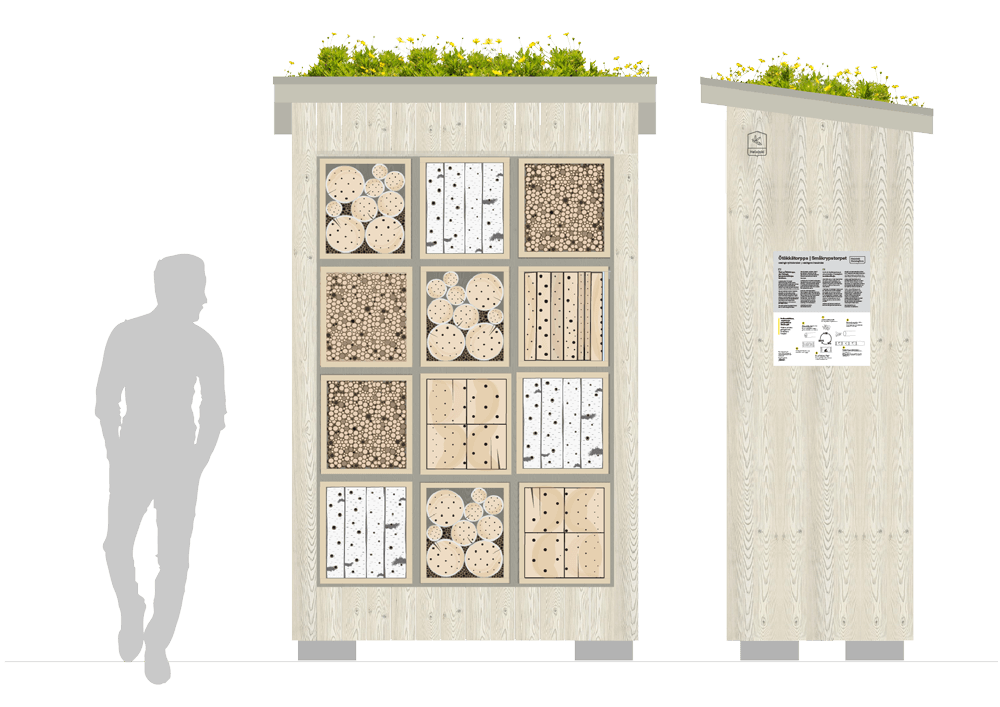The number of pollinator insects has collapsed and the diversity of their species has decreased notably all around the world. The use of detrimental pesticides and dense urban construction, in particular, have been highly disruptive to many pollinator species. A healthy, diverse population of pollinators is, however, important to biodiversity and vital to people’s food production, as many cultivated plants and natural fruit-bearing plants reproduce and produce their crop through insect pollinators’ help.
Insect hotels are nesting places designed for urban solitary bees and Spheciformes. In addition to the insect hotels, it is highly important to also develop the urban green areas into better habitats for pollinators. Favouring diverse vegetation that blooms throughout the growth season and produces plenty of nectar and pollen is a great way of supporting the wellbeing of city-dwelling pollinators and other insects while also promoting the urban biodiversity in general. Use of all pesticides and protective products should also be avoided, especially near the insect hotels.
The City of Helsinki has its own range of insect hotels. The three different insect hotel models are designed for different public urban environments, such as parks, urban gardening plots and schoolyards. Both the City of Helsinki’s insect hotel range and the manual for setting up an insect hotel can be freely utilised by all municipalities, organisations and private individuals.
Insect hotels are intended for species of Hymenoptera nesting in hollow spaces, such as solitary bee and wasp species and other hole and straw nesting wasps in Spheciformes. The parasites of the aforementioned species may also live in the insect hotels. Solitary bee species do not make honey but are excellent pollinators. Solitary wasps and Spheciformes prey on larvae of many species classified as pests, which reduces the need for pesticides. Solitary bees and wasps are more peaceful than those living in colonies and rarely disturb people. The parasites are not harmful, either, and they are just as important a part of the range of species inhabiting diverse urban nature.

The insect hotels feature a range of holes of different sizes drilled into wood and various hollow plant stalks. Each female will build their nest by using rolls of leaves or clay to divide their hole or stalk into chambers. Then they store food in these chambers – either pollen or other insects, depending on the species. Adult Hymenoptera feed on nectar from flowers. This is why it is important to have a wide range of flowering plants growing around the insect hotel.
Insect hotels are primarily intended for nesting places of insect guests, but they are also a great way of learning more about the lives of pollinating insects. Some insect hotel models used in Helsinki have a little hatch for peeking into the nesting holes to see what is going on inside.
By watching the insect hotels, you can also take part in species monitoring by identifying the different species of Hymenoptera visiting the insect hotel with the help of the iNaturalist application, for example. You can record your observations into the Laji.fi database of the Finnish Biodiversity Information Facility, which collects data on the species and quantities of insects found in Finland. You can also take photos of the City of Helsinki’s insect hotels and share them on social media with the hashtag #helsinginhyönteishotellit.
Additional information
Karilas, A.; Kullberg, J.; Lupunen, E.; Mäkinen, S. & Saastamoinen, S. (2022). Lisää pölyttäjiä Helsinkiin! Helsingin hyönteishotellit – käsikirja rakentamiseen ja kunnossapitoon. (More pollinators to Helsinki! The Insect Hotels of Helsinki – Building and Maintenance Manual) Publications of the Urban Environment Division 2022:1
